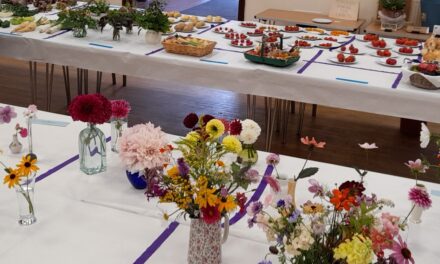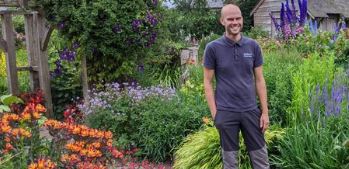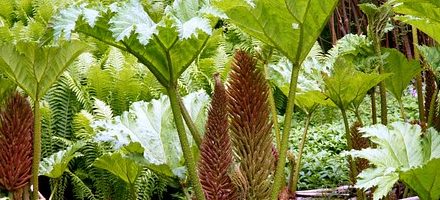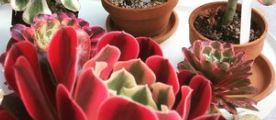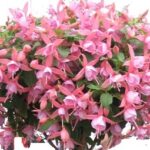A PRODUCTIVE YEAR IN A SMALL GREENHOUSE
On 26 April Orleton and District Gardening Club welcomed Nick Morgan to give a talk entitled A Productive Year In A Small Greenhouse. Nick trained at Pershore and worked for 23 years at RHS Wisley looking after the glasshouses, propagating and cultivating tender plants and now retired gains a lot of satisfaction in caring for his own two greenhouses.
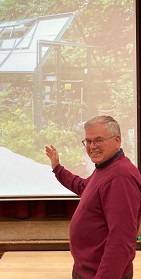 Nick began by urging members to buy the largest greenhouse they could accommodate and afford. Three elements are critical to success, light, temperature and humidity. Ideally a greenhouse should be orientated so that the ridge runs from East to West thus giving a long side facing South to maximise light levels in Spring and Autumn. It is important to keep the glass clean, not just for hygiene but because 1% less light results in 10% less growth.
Nick began by urging members to buy the largest greenhouse they could accommodate and afford. Three elements are critical to success, light, temperature and humidity. Ideally a greenhouse should be orientated so that the ridge runs from East to West thus giving a long side facing South to maximise light levels in Spring and Autumn. It is important to keep the glass clean, not just for hygiene but because 1% less light results in 10% less growth.
Ventilation is critical and Nick advocates bottom vents as well as automatic roof vents to provide good air circulation aiding loss of moisture from the plants which in turn draw up water and nutrients from the roots. In summer ventilation alone is insufficient to keep the temperature below 30degrees when growth will cease. Coolglass sprayed or painted onto the south side or blinds or netting will achieve this and should be applied externally to inhibit short wave light radiation.
The watering regime should strike a balance between moist and aerated compost to avoid soggy rootballs. Seephoses can be used in greenhouse borders or drip feeds in pots. Water butts should be scrubbed out regularly, fitted with tight fitting lids and downpipes should be fitted with filters.
Spring is the busiest time of the gardening year and it is vital to maximise space using benches or staging which also ensure a better quality of light than is received by containers on the floor. Border soil can be prepared from January onwards by incorporating organic matter into the top few inches, a pH of 6.5 to 7 is ideal. Raising the border a few inches by means of planking will make the borders warmer and better aerated. In the cold greenhouse sowing in the border can start in early February with thin sowings of spring onions, salad leaves and round radishes. Strawberries such as Honeoye will crop in May from autumn potted runners overwintered in a cold frame. Nick advised heating with electricity rather than paraffin, cheaper and better for the plants. This must be installed professionally and controlled thermostatically.
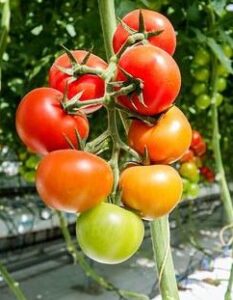 In summer Nick concentrated on the mainstay crops of tomatoes, cucumbers, peppers and aubergines. The club was intrigued to learn Nick’s method of growing tomatoes. He leaves the grobags in the greenhouse for a few days to warm up. They are vigorously plumped up and after drainage holes have been punched in the bases they are placed on capillary matting. Tomatoes are potted into 7 in. pots and these inserted, 3 to a 40L grobag. He grows cucumbers in grobags turned on their side, 2 per bag. Chillies which have small rootball are easy and must be sown in heat in early January. Aubergines are attractive to pests and the use of sticky traps and SB Plant Invigorator is recommended.
In summer Nick concentrated on the mainstay crops of tomatoes, cucumbers, peppers and aubergines. The club was intrigued to learn Nick’s method of growing tomatoes. He leaves the grobags in the greenhouse for a few days to warm up. They are vigorously plumped up and after drainage holes have been punched in the bases they are placed on capillary matting. Tomatoes are potted into 7 in. pots and these inserted, 3 to a 40L grobag. He grows cucumbers in grobags turned on their side, 2 per bag. Chillies which have small rootball are easy and must be sown in heat in early January. Aubergines are attractive to pests and the use of sticky traps and SB Plant Invigorator is recommended.
Sowing must be completed by the first week in October and in winter it is wasteful to heat the greenhouse above 5degrees. Salad leaves may be grown and herbs and Spring bulbs overwintered as well as tender perennials. It is important to ventilate still.
Nick’s talk was practical and informative and ably demonstrated that regardless of style or size the possession of a greenhouse lends an extra dimension to gardening.
Ghislaine Arundale

